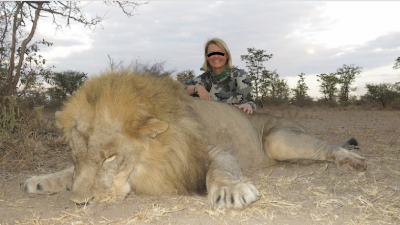|

A Bubye lion according to Martin Nel’s trophy hunting gallery…
A lion trophy hunting raffle (100 tickets at $1,500 each) offered by the Bubye Conservancy in Zimbabwe supposedly to benefit lion research has now been withdrawn. Exposure by the world media could have played a role in this decision – but if it was withdrawn by Bubye, do they acknowledge that it was “wrong” in the first place? If the raffle was to really benefit lion conservation, as was originally stated by Bubye, why did they fold so quickly instead of sticking to their “guns”?
We will probably not get to the bottom of why this decision was made.
But meanwhile, let’s have a look at what the Bubye Valley Conservancy is all about.
History….
The land was originally owned by the Liebig’s Extract of Meat Company (Lemco) that established a vast cattle ranch. From the onset of ranching activities, the managers of the ranch made consistent efforts to eradicate most of the indigenous wildlife. Resident buffalos, lions, and elephants were completely eradicated by the 1990s. But then the ranch was crippled by a devastating drought in 1982/83 and again in 1992/93. The defunct cattle ranch was then sold off to a group of shareholders who established the Bubye Valley Conservancy in 1994.
The Conservancy was then completely fenced with a 2.1m electrified barrier. The main intended form of income was always commercial trophy hunting.
Bubye lions….
About 19 lions were introduced to Bubye in 1999, and the population grew. Oxford University’s Wildlife Conservation Research Unit established a lion research programme in 2009. Supposedly, their research goals were diverse, including such aims as understanding the ecology of lions on a fenced reserve AND the effect of trophy hunting on lion population dynamics.
Note that lions were primarily introduced to benefit commercial trophy hunting.
Supposedly, Bubye provided a unique opportunity to study African lions within a trophy hunting area and that the lion population dynamics were also going to be monitored and modelled to assess sustainable trophy hunting. Really? Lion trophy hunting success on Bubye is close to 100%. In 2012, a quota of 12 lions was issued and 12 lions were killed. Of course! These lions live behind a 2.1 metre fence! The fenced lions do not live in any “natural” environment, and are there to be shot.
Given the above, it is little surprising that Bubye lion research via Oxford University has provided minimal promised results. There have resulted no significant scientific publications regarding the effect of trophy hunting on a fenced lion population. Yet Paul Trethowan of Oxford University wrote a letter to the US Fish and Wildlife Service urging them not to list lions on the US Endangered Species Act based on the “success” of Bubye’s fenced lion population. Trethowan was worried that the USA would cease imports of lion trophies – a main source of income from the fenced reserve of Bubye.
Lion trophy hunting….
Bubye, as mentioned above, is a fenced reserve. Lions were introduced as a hunting commodity and are now being trophy hunted.
Are the Bubye fenced lions offered to trophy hunter’s guns anything to do with wild lion conservation? Is Bubye like another form of “canned hunting” – lions behind fences that have no opportunity to escape the hunter? And where the Conservancy is so sure of a “kill” that they offered a “raffle” for a trophy?
Oxford University recently said they would not accept research funding from a raffled trophy hunt following global media pressure. Now let’s have them justify their “research” programme on Bubye and how they think lion trophy hunting of an introduced lion population on a fenced reserve will benefit wild lion conservation.
Picture credit : Martin Nel
|




